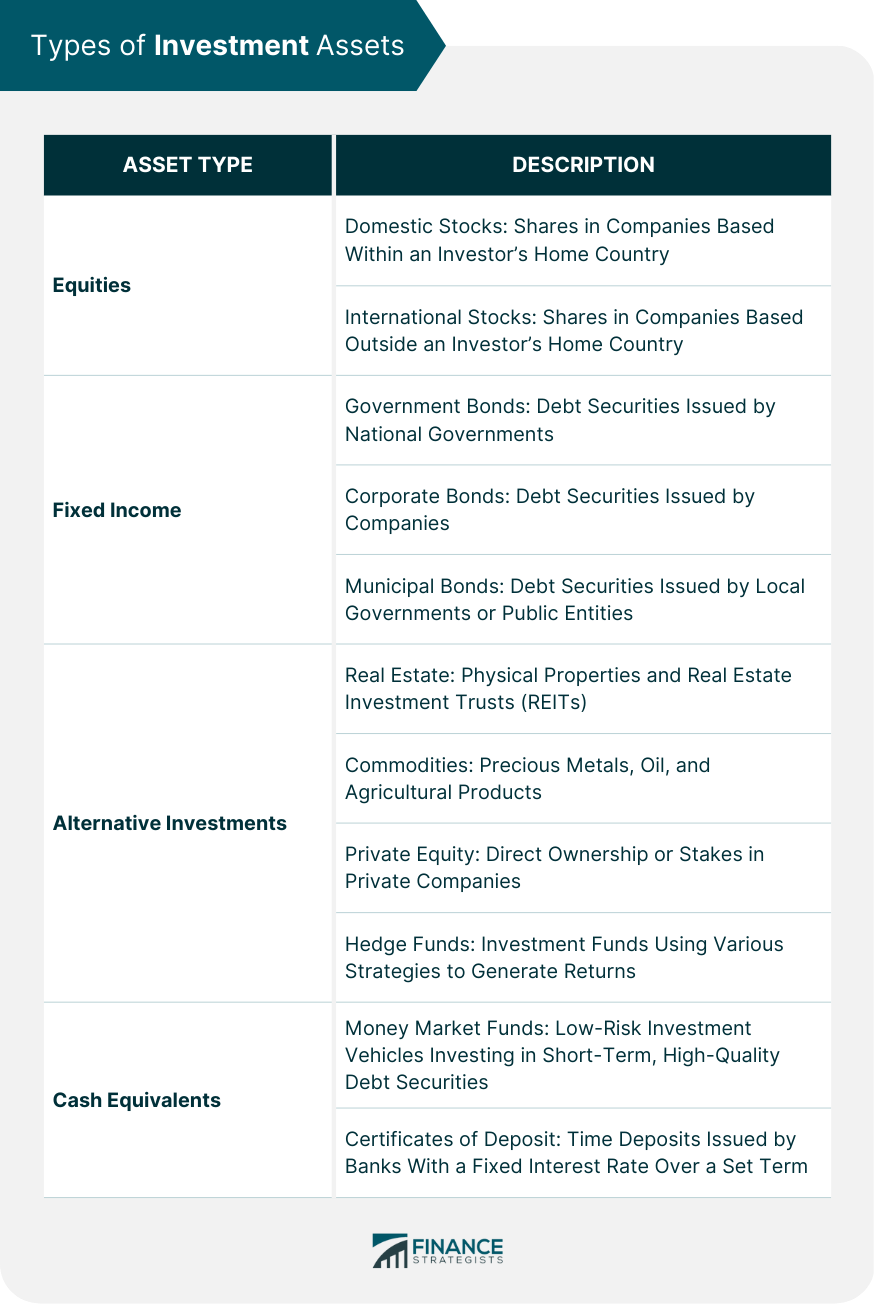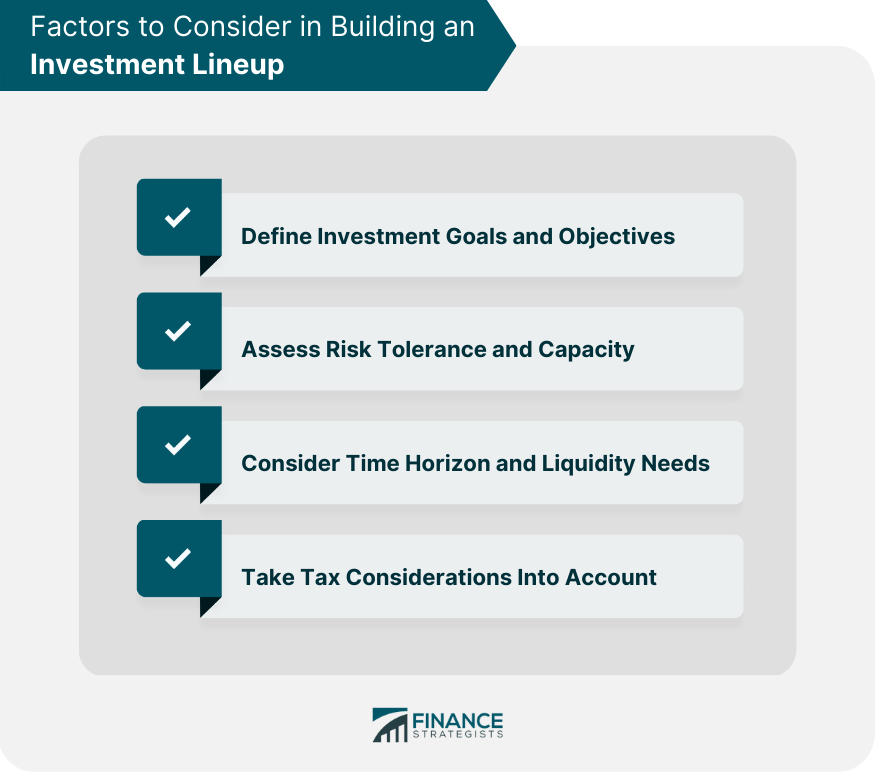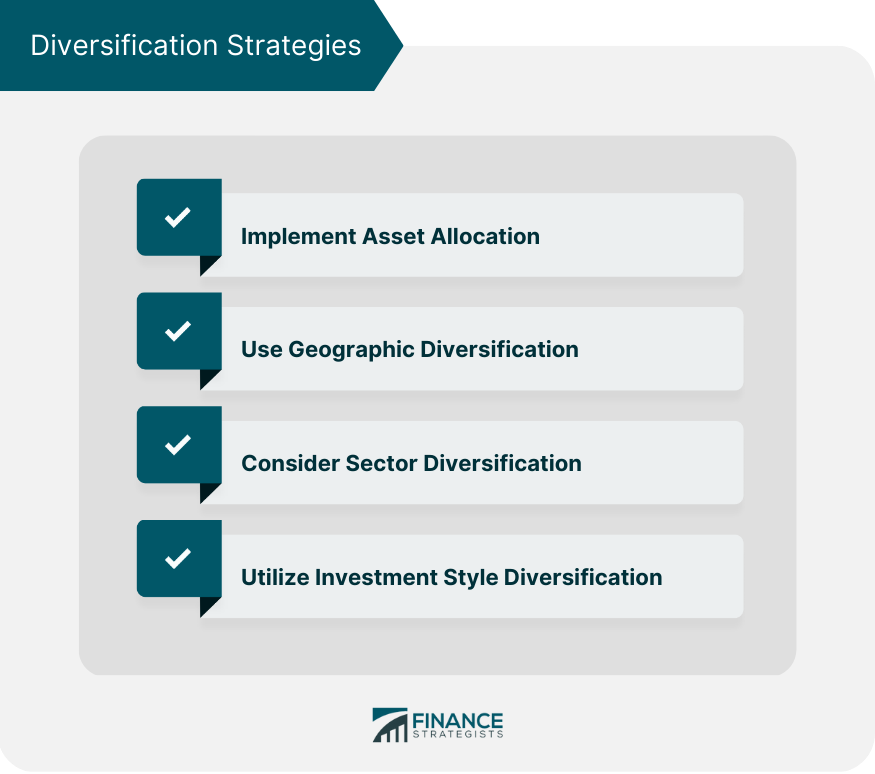An investment lineup is a selection of investment options available to an investor in a defined contribution plan, such as a 401(k) or 403(b). The investment lineup typically consists of a range of mutual funds, exchange-traded funds (ETFs), and other investment products that an investor can choose to allocate their retirement savings. The investment lineup is usually selected by the plan sponsor, such as an employer, or the plan administrator, and is designed to provide a diversified set of investment options that can help investors achieve their retirement goals. The investment options in the lineup may vary in terms of asset class, investment style, risk level, and fees. Domestic stocks represent shares of ownership in companies based within an investor's home country. Investing in domestic stocks allows investors to participate in the growth of their country's economy. International stocks offer investors exposure to companies based outside their home country. Investing in international stocks can provide additional diversification and access to growth opportunities in emerging and developed markets. Government bonds are issued by national governments to fund public projects or refinance existing debt. They are generally considered to be lower-risk investments and can provide a steady stream of income. Corporate bonds are issued by companies to raise capital for business expansion or other purposes. They typically offer higher yields than government bonds but carry higher risk. Municipal bonds are issued by local governments or other public entities to fund public projects like infrastructure or schools. They offer tax advantages for investors in the United States, as interest income is generally exempt from federal income taxes. Real estate investments include both physical properties and real estate investment trusts (REITs). They can provide income through rental payments and potential capital appreciation. Commodities, such as precious metals, oil, and agricultural products, can offer diversification benefits and act as a hedge against inflation. Private equity investments involve the direct ownership of private companies or stakes in private companies. They can offer high returns but are less liquid and carry higher risk. Hedge funds are investment funds that use various strategies to generate returns, often with limited correlation to traditional asset classes. They can be complex and carry high fees but may offer diversification benefits. Money market funds are low-risk investment vehicles that invest in short-term, high-quality debt securities, providing investors with liquidity and preservation of capital. Certificates of Deposit (CDs) are time deposits issued by banks that pay a fixed interest rate over a specified term. They offer a low-risk option for investors seeking capital preservation and a predictable income stream. Investors should clearly define their financial goals and objectives, such as saving for retirement, funding education, or buying a home, to guide their investment lineup decisions. Understanding an investor's risk tolerance and capacity is essential in building an appropriate investment lineup. Investors should consider their ability and willingness to withstand potential losses or fluctuations in the value of their investments. The investment time horizon, or the length of time an investor expects to hold investments before needing the funds, plays a significant role in determining the appropriate investment lineup. Investors should consider their liquidity needs, or the ability to quickly convert investments into cash without incurring significant losses when selecting investments for their lineup. Tax implications, such as capital gains taxes or tax-exempt investments, should be considered when building an investment lineup to maximize after-tax returns. Asset allocation involves spreading investments across various asset classes, such as equities, fixed income, and alternative investments, to reduce risk and increase potential returns. Geographic diversification involves investing in assets from different countries or regions to mitigate country-specific risks, such as political instability or economic downturns. Sector diversification refers to investing across various industries and sectors, such as technology, healthcare, or consumer goods, to reduce the impact of sector-specific risks on an investment portfolio. Investment style diversification involves investing in different investment styles, such as growth, value, or dividend-focused strategies, to benefit from various market conditions and reduce overall portfolio risk. Mutual funds pool money from multiple investors to invest in a diversified portfolio of stocks, bonds, or other assets, offering instant diversification and professional management. ETFs are investment funds that trade on stock exchanges like individual stocks. They offer many of the same diversification benefits as mutual funds, with added advantages such as intraday trading and potentially lower fees. Investing directly in individual stocks and bonds allow investors to build a customized investment lineup but may require more time and expertise to manage effectively. Managed accounts involve hiring a professional investment manager to build and maintain a customized investment lineup on an investor's behalf, typically for a fee. Regularly reviewing the performance of investments within an investment lineup is crucial for identifying underperforming assets and ensuring the portfolio remains aligned with an investor's goals and risk tolerance. Rebalancing involves adjusting the allocation of assets within an investment lineup to maintain the desired level of diversification and risk exposure. Investors should establish a rebalancing frequency and set thresholds for when adjustments should be made. When rebalancing, investors should consider tax-efficient strategies, such as selling assets with losses to offset gains or utilizing tax-advantaged accounts, to minimize the tax impact of portfolio adjustments. Working with a financial advisor can provide investors with expert guidance, tailored investment recommendations, and ongoing support in managing their investment lineup. Choosing the right financial advisor involves evaluating factors such as credentials, experience, investment philosophy, and communication style. Understanding a financial advisor's fee structure and ensuring transparency in costs is essential for investors to make informed decisions about the value of professional advice. Building a strong investment lineup is crucial for long-term success in achieving financial goals. Investors need to consider various factors, including investment goals and objectives, risk tolerance, time horizon, liquidity needs, and tax considerations when selecting investment assets. Diversification strategies, such as asset allocation, geographic diversification, sector diversification, and investment style diversification, can help reduce portfolio risk and increase potential returns. There are various investment vehicles available, such as mutual funds, ETFs, individual stocks and bonds, and managed accounts, that offer different levels of diversification and professional management. Monitoring and rebalancing the investment lineup regularly is essential to ensure it remains aligned with the investor's goals and risk tolerance. Finally, working with a financial advisor can provide investors with expert guidance and ongoing support in managing their investment lineup. By understanding these concepts and implementing them, investors can build a well-diversified and balanced investment lineup that can help them achieve their financial goals over the long term.What Is Investment Lineup?
Types of Investment Assets

Equities
Domestic Stocks
International Stocks
Fixed Income
Government Bonds
Corporate Bonds
Municipal Bonds
Alternative Investments
Real Estate
Commodities
Private Equity
Hedge Funds
Cash Equivalents
Money Market Funds
Certificates of Deposit
Factors to Consider in Building an Investment Lineup

Investment Goals and Objectives
Risk Tolerance and Capacity
Time Horizon
Liquidity Needs
Tax Considerations
Diversification Strategies

Asset Allocation
Geographic Diversification
Sector Diversification
Investment Style Diversification
Investment Vehicles
Mutual Funds
Exchange-Traded Funds
Individual Stocks and Bonds
Managed Accounts
Monitoring and Rebalancing
Performance Evaluation
Rebalancing Frequency and Thresholds
Tax-Efficient Rebalancing Strategies
Working With a Financial Advisor
Benefits of Professional Advice
Selecting a Financial Advisor
Fee Structures and Transparency
Conclusion
Investment Lineup FAQs
An investment lineup is a collection of investment assets or vehicles designed to help investors achieve their financial goals while minimizing risk. A well-diversified investment lineup is essential for long-term investment success, as it can reduce the impact of individual asset volatility and provide exposure to a range of growth opportunities.
To create a diversified investment lineup, consider incorporating a mix of asset classes (equities, fixed income, alternative investments, and cash equivalents), geographic regions, sectors, and investment styles. This diversification can help reduce portfolio risk and increase the potential for returns.
When building an investment lineup, consider factors such as your investment goals and objectives, risk tolerance and capacity, time horizon, liquidity needs, and tax considerations. These factors will help guide your investment decisions and ensure your investment lineup aligns with your financial situation and objectives.
To monitor and rebalance your investment lineup, regularly review the performance of your investments and compare them to your investment goals and risk tolerance. Establish a rebalancing frequency and set thresholds for when adjustments should be made. When rebalancing, consider tax-efficient strategies to minimize the tax impact of portfolio adjustments.
A financial advisor can provide expert guidance, tailored investment recommendations, and ongoing support in managing your investment lineup. They can help you build a well-diversified portfolio, monitor performance, and make adjustments as needed to keep your investments aligned with your financial goals and risk tolerance. Additionally, they can offer tax-efficient strategies and assist with selecting appropriate investment vehicles
True Tamplin is a published author, public speaker, CEO of UpDigital, and founder of Finance Strategists.
True is a Certified Educator in Personal Finance (CEPF®), author of The Handy Financial Ratios Guide, a member of the Society for Advancing Business Editing and Writing, contributes to his financial education site, Finance Strategists, and has spoken to various financial communities such as the CFA Institute, as well as university students like his Alma mater, Biola University, where he received a bachelor of science in business and data analytics.
To learn more about True, visit his personal website or view his author profiles on Amazon, Nasdaq and Forbes.











